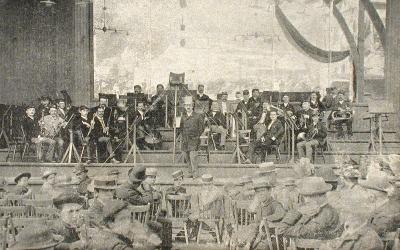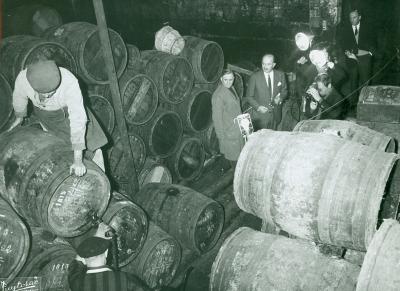Latin American Montrealers celebrate Christmas with traditions from their countries of origin and from Québec. The holiday season represents a time for spiritual reflection, shared moments with family and friends, and, above all, celebration.
Many in the Montréal Latin American community participate in religious celebrations commemorating the birth of Jesus Christ. Household practices vary depending on country of origin, but generally follow Catholic or Protestant traditions. Common elements across Latin American countries include Christmas trees, advent wreaths, stockings hung by the chimney, candy canes, and nativity scenes depicting the birth of Jesus. The Christmas season is also filled with songs and stories honouring the Christ child, Saint Nicholas, and Santa Claus.
Traditional Christmas celebrations
Noël latino-américain
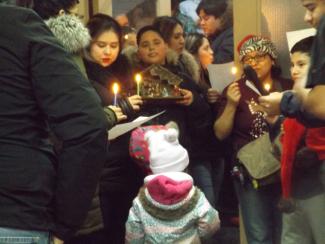
Fifty people from the Latin American community in Montréal spoke to us about how they celebrate Christmas. Among them was Reverend Percy Diaz, a priest at Notre-Dame-de-Guadalupe who helps run the Latin American mission of the Diocese of Montréal. According to Father Diaz, Christmas festivities in the community combine traditions from Latin America with those of Québec and North America, reflecting a significant syncretism, or merging, of religious traditions.
Many celebrations take place in the lead-up to Christmas. These include traditional activities like Día or Noche de las Velitas, Las Posadas, Novena de Aguinaldos, El Pesebre (the crèche) and gatherings with family or friends at home or at church. There is a special mass for children, the morning hymn to the Virgin, and breakfast with friends after morning prayer. Father Diaz points out that in Latin American Catholicism, Christmas celebrations have both an inner, more personal significance and a broader one related to the community, where celebrations take place based on each country’s customs.
Among the most beloved Latin American Christmas celebrations are Noche de las Velitas (Little Candles Day), La Gritería (“the shouting” or “the screaming”), Las Posadas (“the inns”), Novena de Aguinaldos (a nine-day nativity tradition), and Christmas Eve.
Noche de las Velitas, a widely observed Colombian holiday, is the first in a series of sacred celebrations that run until January 6. Traditionally, Noche de las Velitas is celebrated after sunset on December 7 or at dawn on December 8, depending on the region of the country. Lanterns and candles are lit, illuminating streets and shopping areas, and lights glow in the windows of homes across the country to celebrate the Feast of the Immaculate Conception.
Noël latino-américain - natilla
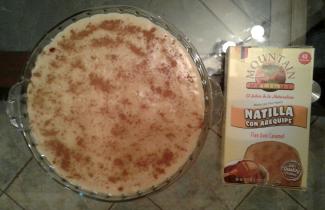
Noche de las Velitas celebrations also include traditional Christmas dishes, such as natilla, a Colombian-style pudding prepared with cornstarch, milk, panela (unrefined whole cane sugar), cinnamon, butter, liqueur and vanilla extract, and buñuelos, a dough fritter made with water, milk, eggs, yeast, and cheese. There are many variations on these two traditional Christmas desserts across Latin America.
Mariachi serenades
Noël latino-américain
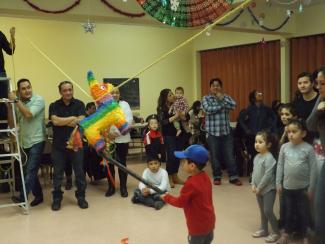
La Gritería is a Nicaraguan holiday that celebrates the conception of the Virgin Mary. It takes place on December 7, on the eve of the Catholic Feast of the Immaculate Conception. In addition to a special service, mariachis play a serenade in honour of the Virgin.
Las Posadas is a religious festival celebrated in Mexico, Honduras, Guatemala, El Salvador, Nicaragua, Costa Rica, and Panama during the nine days before Christmas. People reenact Mary and Joseph’s nine-day pilgrimage from Nazareth to Bethlehem looking for a place for the Christ child to be born. In Montréal, parishioners visit the homes of family members, in memory of the pilgrimage. During the nine days of religious activities, people pray and meet with other members of their parish, including family, friends, and strangers.
The Novena de Aguinaldos is similar to Las Posadas. A Catholic custom with roots in Colombia, Venezuela, and Ecuador, the holiday brings together believers who live on the same street. For nine days, neighbours visit a different home each night to pray, sing Christmas hymns, and eat traditional Christmas treats together. Most Montrealers from these countries whom we interviewed said they continue to celebrate the novena with their children and families, keeping their country’s Christmas traditions alive and passing them down to the next generation.
In Montréal, Latin American parishioners can find programming that incorporates the customs and rituals of their countries of origin into the church’s Christmas festivities. Generally, December 24 starts with concerts and ends with the Nochebuena mass, also called misa de gallo—known to Canadians as midnight mass.
Christmas Day mass is the final December celebration. Christmas services for the Latin American community in Montréal are usually held at Notre-Dame-de-Guadalupe, home to the city’s Latin American Catholic mission. There are also services at St. Joseph’s Oratory and a number of other churches, including Sainte-Thérèse-d’Avila, Saint-Gilbert, Saint-Arsène, and Notre-Dame-du-Bel-Amour. A handful of Catholic fraternities and brotherhoods organize these Christmas activities, including those of El Señor de los Milagros, San Martin de Porres, Santa Rosa de Lima, San Judas Tadeo, and the Divino Salvador del Mundo. In an article about Montréal’s Latin American Catholic mission, Sabrina Di Matteo notes that for brotherhood members, “fraternal communion and religious celebrations have universal meaning and represent the summit of Christian life,” notes Sabrina Di Matteo in her article “Signes de vie: la mission Notre-Dame-de-Guadalupe.”
Christmas with family and in the community
Noël latino-américain
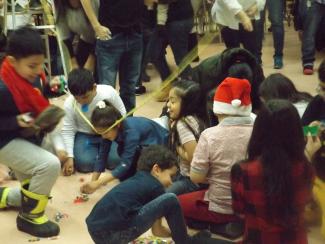
Christmas is a major religious event, and Latin American Catholics in Montréal celebrate it twofold, first with their families, in thankfulness to God for the gifts given during the year and with a desire to pass on the Catholic tradition to the younger generations; and then in the community, reinforcing bonds with friends and family and celebrating with music, dance, and generosity. At Christmas, aspects of Catholic spirituality (higher forms of reflection, a desire for forgiveness and to forgive, and the nourishing of family bonds) blend with community-centred pagan elements, where dance and sharing take a central role in celebrations. With this duality, Latin American Montrealers retain their relationship to their countries of origin, in spite of the cold Montréal weather, loneliness, and challenges of life in a new country. End-of-year celebrations help preserve religious traditions which, even after long years in Québec, continue to be passed down through the generations.
Christmas is an important day for most Latin American Montrealers, but traditions vary depending on the country. For some, mass is an important ritual, while others prefer to gather at home with family, or friends who have become family. There is generally a toast, with a glass of wine or bubbles. There are presents. Ecuadorians, for instance, tend to gift each other traditional handicrafts. The Christmas dinner spread includes Québec dishes and traditional recipes from back home—Bolivian hot chocolate, various versions of tamales or hallacas from Central America, Colombia, and Venezuela, Colombian ajiaco, and Argentinian lechon. And, of course, turkey. Plenty of juice and beer accompany the meal, and after dinner comes a vast array of desserts.
In Christmas celebrations at the church, elements of Québec traditions are sometimes incorporated to include people from different backgrounds. Sabrina Di Matteo notes that many Montrealers who speak Spanish have begun attending Latin American services—something which, along with marriages between Latin Americans and Quebecers, has contributed to a blending of Québec and Latin American Christmas traditions.
The New Year
Noël latino-américain - famille Gomez
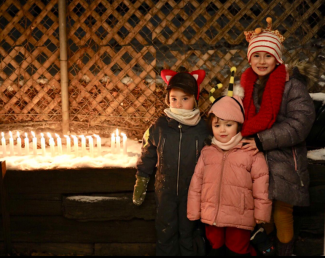
Latin Americans ring in the New Year in a more informal style. The people surveyed said they usually spend it with family and friends. Some go out to bars, nightclubs, or restaurants to celebrate as a group. No matter the location, there are the same New Year’s rituals, whether it is the eating of twelve grapes at midnight, a champagne toast, the wearing of yellow underwear, or a trip around the block with a suitcase.
In general, the families with Latin American roots we spoke to said they try to preserve the holiday traditions from their countries of origin and pass them down to their children. These customs combine religious and pagan practices. It is not always possible to recreate tradition here in Québec, however. Family members and friends are often far away, and the climate is very different, making it necessary to adapt. Many parents try to pass on to their children the traditions they have kept alive for generations. These traditions end up changing when people from different backgrounds become part of the family, bringing with them their own traditions. While it is difficult to see certain old traditions from their countries fade away, new rituals emerge, in the spirit of openness and inclusion of others.
Faith and Latin American Montrealers
According to Canada’s 2016 Census, the City of Montréal was home to 166,180 individuals from the geocultural region designated as “Latin America,” which includes Central America, South America and the Hispanic Caribbean. 85.9% of these individuals identified as Christian, and of these Christians, 80% identified as Roman Catholic. The remaining 19% said they belonged to different Protestant religious groups. Some of the Latin American Montrealers surveyed said they were Catholic but not practising; and a small percentage said they were Jewish, Muslim, Buddhist, or atheist.
DI MATTEO, Sabrina. « Signes de vie : la mission Notre-Dame-de-Guadalupe », Haute-Fidélité, vol. 125, no 4, 2007.

